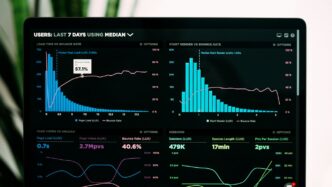Introduction
The web design industry is changing due to artificial intelligence (AI). The way AI is being incorporated into digital design processes is changing the standards for web design. It ushers in a new era of intelligent, user-focused, and efficient websites. In this piece, we examine how AI is changing the rules for AI web designer, improving user experiences, and influencing how digital spaces will develop in the future.
What is Artificial Intelligence in Web Design?
Understanding AI and Machine Learning in Design
Technologies like computer vision, natural language processing, and machine learning are all included in the category of artificial intelligence. AI is used in web design to produce tools that can generate predictions, learn from data, and automate laborious activities. This results in quicker and more intuitive design processes.
How AI Influences Web Design
AI has a significant impact on site design. By generating responsive layouts, recommending color schemes, and even optimizing content for improved user interaction, automated design tools make the process of creating websites easier. As a result, designers may concentrate on their creative work while AI takes care of tedious chores.
Key Benefits of AI in Web Design
Speed and Efficiency in Design Processes
AI speeds up the design process in numerous ways, including the creation of wireframes and coding components. This speed gives companies a competitive edge by enabling them to develop websites more quickly and instantly adjust to market trends.
Personalized User Experiences
With AI, websites may adapt to user behavior and preferences. Product recommendations and dynamic material catered to each visitor are examples of this customization. Users feel more a part of the website as a result, and this can increase engagement and conversion rates.
Cost Efficiency for Businesses
AI lessens the need for expensive, time-consuming manual labor in web creation. Businesses can reduce development expenses and retain high-quality output by automating several procedures. Because of this, AI is a desirable choice for both businesses and startups.
AI Tools Transforming Web Design
AI-Powered Design Software
Designers can create websites that are both aesthetically pleasing and practical with the aid of AI-powered tools like Adobe Sensei, Figma, and Wix ADI. These technologies use AI to improve user interaction, optimize layouts, and recommend design features.
Chatbots and Virtual Assistants
Chatbots powered by AI are becoming commonplace on a lot of websites. They answer user questions, offer immediate assistance, and direct users through the website. This guarantees round-the-clock help and lessens the need for human support representatives.
AI in Content Generation
AI is also transforming the creation and administration of content. Articles, product descriptions, and social media postings can be produced by tools such as GPT-based models. This enables companies to produce content consistently without requiring a lot of physical labor.
How AI Enhances User Experience (UX)
Personalization Techniques
AI analyzes user data to enable websites to provide a customized experience. This could entail tailoring the website’s interface to the preferences of the user or presenting various product recommendations based on prior interactions.
Predictive Analysis for User Needs
Artificial Intelligence can anticipate user needs by examining trends in their behavior. This improves user experience overall by streamlining navigation and enabling websites to proactively provide solutions or recommendations.
Voice User Interfaces (VUIs)
The way people interact with technology has changed as a result of voice assistants like Alexa and Siri. When websites with voice user interfaces (VUIs) are integrated, users can do activities using voice commands, making for a more natural and hands-free surfing experience.
Challenges of Integrating AI in Web Design
Technical Complexity
When integrating AI into web design, a thorough grasp of algorithms and data analysis is frequently necessary. For small organizations, this can be a hurdle, as they may lack the means or experience to apply AI solutions.
Data Privacy Concerns
For AI to work well, enormous volumes of user data are necessary. Data security and privacy are brought up by this. Designers are responsible for making sure that data is managed responsibly and in accordance with laws such as GDPR.
Balancing Automation with Human Creativity
Although AI is strong, it does not have the same intuitive creativity as human creators. To create websites that are both useful and distinctive, it’s critical to strike a balance between the efficiency of AI and the artistic vision of designers.
The Future of AI in Web Design
Emerging Trends in AI-Driven Design
As AI continues to advance, we may expect trends like augmented reality (AR) and virtual reality (VR) to be incorporated into web design. Websites will become more interactive as a result of these technologies’ more immersive experiences.
The Role of AI in Responsive Design
AI has the ability to automatically modify website designs to match various screen sizes and gadgets. In order to accommodate the expanding number of mobile users, this guarantees a fluid experience across desktops, tablets, and smartphones.
AI as a Collaborative Tool for Designers
AI is not meant to replace designers but to work alongside them. AI improves web design projects by freeing up designers to concentrate on creativity and innovation by handling monotonous duties.
Conclusion
AI has revolutionized site design by providing unprecedented speed, efficiency, and personalization. It enables companies to design stunning websites that also adjust to the needs of users. Even with these obstacles, AI in web design has a bright future ahead of it, offering fresh approaches to user engagement and improving digital experiences.
FAQs
How does AI improve web design?
AI improves web design by automating tasks, personalizing user experiences, and enhancing design efficiency.
Can AI fully replace human web designers?
No, AI cannot fully replace human designers. It serves as a tool to assist them, allowing for greater creativity and efficiency.
What are the risks of using AI in web design?
The main risks include data privacy concerns, the need for specialized knowledge, and the potential loss of human creativity in designs.
Which AI tools are best for web design?
Popular AI tools for web design include Wix ADI, Adobe Sensei, Figma, and GPT-based content generators.
How does AI impact website SEO?
AI can optimize content for SEO by analyzing keywords, improving site structure, and predicting user behavior, leading to better search engine rankings.












